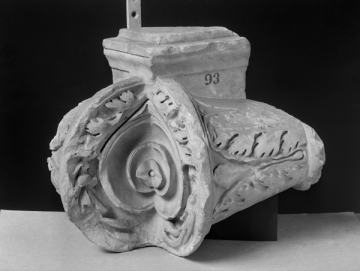Explore Collections


You are here:
CollectionsOnline
/
Fragment of an ionic corner capital
Browse
Fragment of an ionic corner capital
69-96 AD
Flavian
Flavian
Luna marble
Height: 34cm
Width (side with Museum number): 46cm
Length: 24cm
Width (side with Museum number): 46cm
Length: 24cm
Museum number: M93
On display: Museum Corridor - outside the Picture Room
All spaces are in No. 13 Lincoln's Inn Fields unless identified as in No. 12, Soane's first house.
For tours https://www.soane.org/your-visit
Curatorial note
The two adjoining volutes of an Ionic corner capital enriched with carved acanthus leaves and a rosette flower at their common centres. Above, a fillet and cyma reverse corner moulding. The raised, inset surface of the top supported the entablature in such a way as to ensure an amount of free space between the moulding strips in case the building settled.
The curious arrangement of two balusters joining face to face at the edge of an Ionic capital indicates that this fragment could only be from the inside corner of the capital and column at the right-angle corner of the building. A rectangular Greek temple of the Ionic order would have at least four of these capitals, or more, depending on the number of rows of columns (compare to the angle column from the Ionic temple at Priene1). A Roman pseudo-peripteral temple with enraged columns on the cella walls at the back and sides and rear might only have two at the corners of the pronaos. The number on other public buildings or in the peristyle courts of villas, etc. would naturally vary according to the design.
This particular section, one of the few architectural fragments in the Soane collection which does not belong with the C.H. Tatham examples collected in and about Rome, may be considered first rate work of the Flavian period2. In later Hellenistic architecture, the West Portal of the Agora at Ephesus, which has been dated to the end of the second century BC, had Ionic corner capitals of similar arrangement on the columns at the juncture between façade and wings3, and in late Republican Rome we find such capitals, although now in sadly mutilated condition, on the well preserved square or rectangular temple beside the Tiber4. In stylistic detail this fragment is quite similar to an Ionic capital in the Church of S. Maria in Trastevere, Rome, with which also belong examples in the Vatican collections5.
1 Speltz and Spiers, Styles of Ornament, pl. 20, no. 8. More recent on the development of the Greek Ionic corner volute, Manolis Korrés, Ein Beitrag zur Kenntnis der attisch-ionischen Architektur, Säule und Gebälk, Mainz 1996, pp. 90 - 112. See also Rykwert, The Dancing Column, p.246.
2 The standard work on Flavian decoration remains P.H. von Blanckenhagen, Flavische Architektur und ihre Dekoration untersucht am Nervaforum, Berlin, 1940.
3 Forschungon in Ephesos, III, pp. 28 ff., figs. 42, 44, 45, pl. I.
4 A. Bartoli, Uffizi Sketchbooks, V, pl. CDLIII, fig. 833; Canina, Edifici di Roma, II, pl. XLI. [this reference needs to be checked]
5 For the former and for identifications, see G. De Angelis d'Ossat, "Il capitello ionico della Basilica Emilia", in Roma, 1943, p.78 f., pl. XI, fig.a. On S. Maria in Trastevere see Krautheimer, Corpus, vol. III, pp. 65-71.
The curious arrangement of two balusters joining face to face at the edge of an Ionic capital indicates that this fragment could only be from the inside corner of the capital and column at the right-angle corner of the building. A rectangular Greek temple of the Ionic order would have at least four of these capitals, or more, depending on the number of rows of columns (compare to the angle column from the Ionic temple at Priene1). A Roman pseudo-peripteral temple with enraged columns on the cella walls at the back and sides and rear might only have two at the corners of the pronaos. The number on other public buildings or in the peristyle courts of villas, etc. would naturally vary according to the design.
This particular section, one of the few architectural fragments in the Soane collection which does not belong with the C.H. Tatham examples collected in and about Rome, may be considered first rate work of the Flavian period2. In later Hellenistic architecture, the West Portal of the Agora at Ephesus, which has been dated to the end of the second century BC, had Ionic corner capitals of similar arrangement on the columns at the juncture between façade and wings3, and in late Republican Rome we find such capitals, although now in sadly mutilated condition, on the well preserved square or rectangular temple beside the Tiber4. In stylistic detail this fragment is quite similar to an Ionic capital in the Church of S. Maria in Trastevere, Rome, with which also belong examples in the Vatican collections5.
1 Speltz and Spiers, Styles of Ornament, pl. 20, no. 8. More recent on the development of the Greek Ionic corner volute, Manolis Korrés, Ein Beitrag zur Kenntnis der attisch-ionischen Architektur, Säule und Gebälk, Mainz 1996, pp. 90 - 112. See also Rykwert, The Dancing Column, p.246.
2 The standard work on Flavian decoration remains P.H. von Blanckenhagen, Flavische Architektur und ihre Dekoration untersucht am Nervaforum, Berlin, 1940.
3 Forschungon in Ephesos, III, pp. 28 ff., figs. 42, 44, 45, pl. I.
4 A. Bartoli, Uffizi Sketchbooks, V, pl. CDLIII, fig. 833; Canina, Edifici di Roma, II, pl. XLI. [this reference needs to be checked]
5 For the former and for identifications, see G. De Angelis d'Ossat, "Il capitello ionico della Basilica Emilia", in Roma, 1943, p.78 f., pl. XI, fig.a. On S. Maria in Trastevere see Krautheimer, Corpus, vol. III, pp. 65-71.
Unrecorded.
Literature
Description, 1836, plate IX.
Soane collections online is being continually updated. If you wish to find out more or if you have any further information about this object please contact us: worksofart@soane.org.uk


